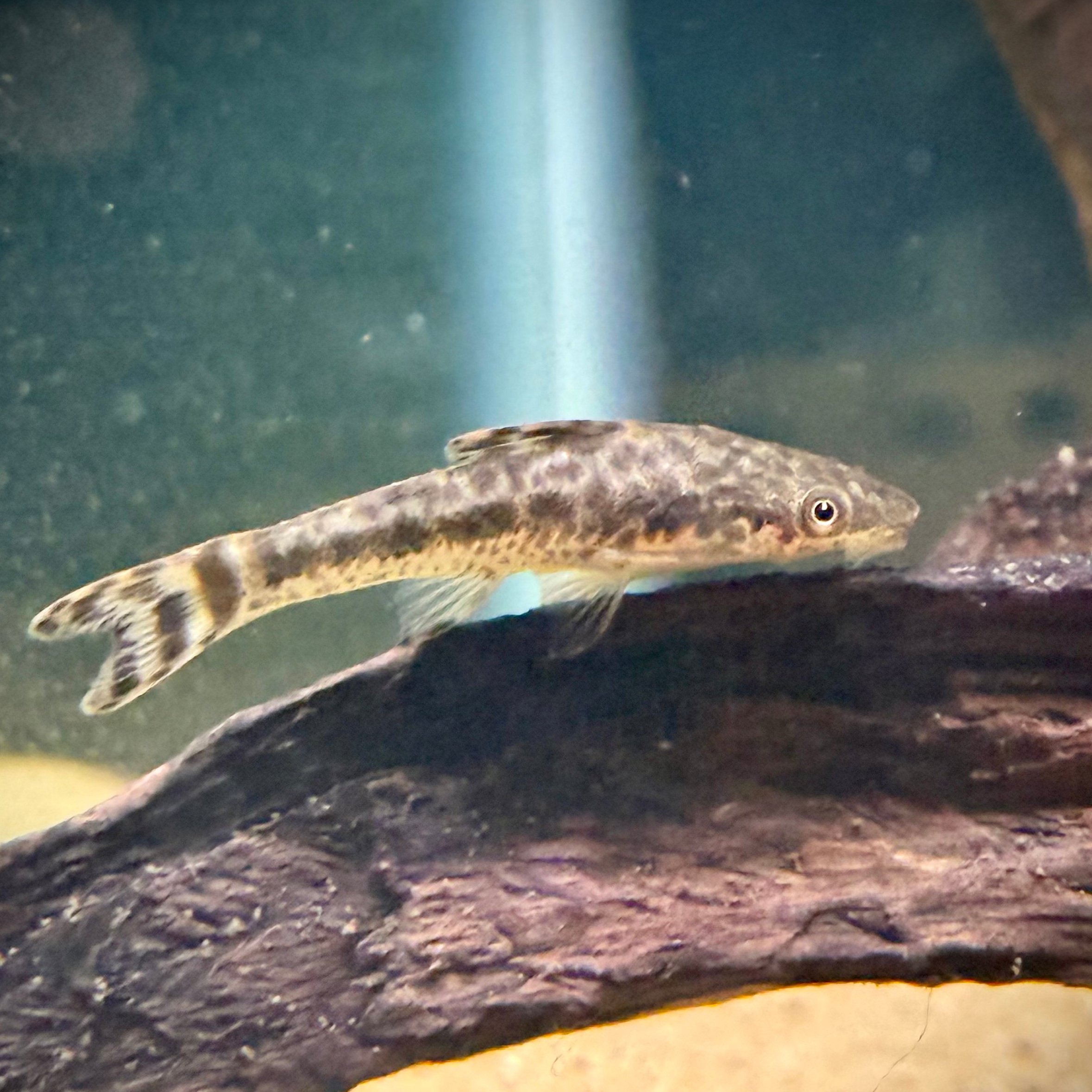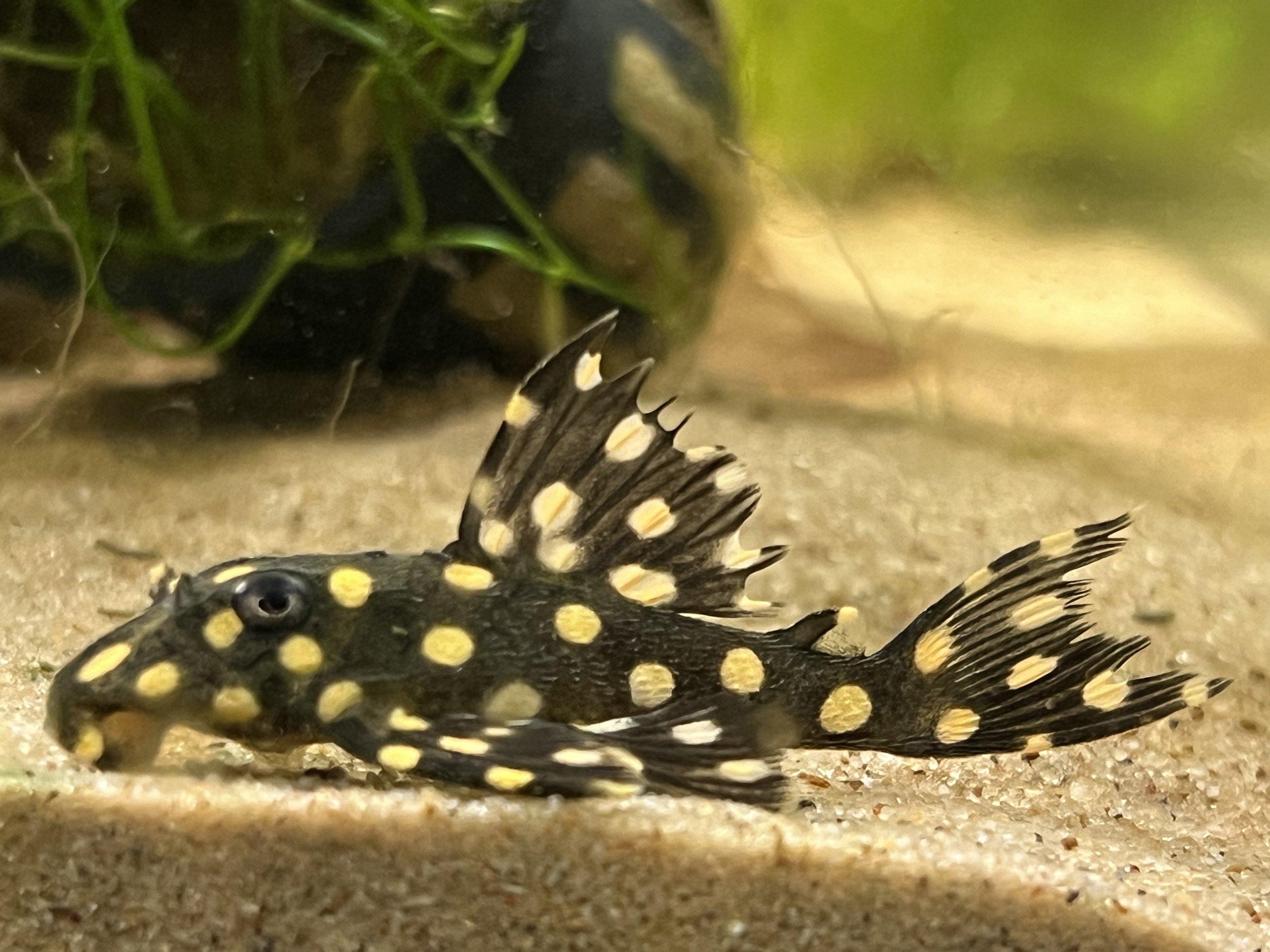 Image 1 of
Image 1 of


Otocinclus arnoldi-L
Otocinclus arnoldi, commonly known as Arnold’s Otocinclus, is a distinctive and somewhat less-common species of freshwater catfish native to tributaries and streams within the Amazon basin, particularly in Peru and parts of Brazil. Appreciated in the aquarium hobby primarily for its excellent algae-eating abilities, peaceful temperament, and small size, this species offers both functional and aesthetic value to community and planted aquariums.
Physically, Otocinclus arnoldi stands out among other Otocinclus species due to its unique coloration and pattern. Unlike common Otocinclus species, Arnold’s Otocinclus displays a mottled or speckled appearance characterized by irregular patches of darker pigment scattered along its lighter, tan to yellowish body. This patterning creates a distinctive, irregular marbled appearance. Additionally, its fins often exhibit subtle spotting or speckling, adding to its visual appeal. Adults typically reach a maximum size of around 1.4 to 1.6 inches (3.5 to 4 centimeters), making it suitable for nano or moderately sized aquariums.
In the aquarium, Otocinclus arnoldi should always be kept in small groups of at least five to encourage natural social behaviors and reduce stress. A tank size of 10 gallons is sufficient for a small group, but larger, densely planted aquariums are ideal for providing ample surfaces for algae grazing and biofilm development. The aquarium should include driftwood, smooth rocks, and numerous aquatic plants to mimic their natural habitat and ensure their nutritional needs are met.
Suitable water parameters include temperatures ranging from 72 to 80°F (22 to 27°C), slightly acidic to neutral water with a pH of 6.0 to 7.5, and soft to moderately hard water. Maintaining pristine water quality through frequent water changes and effective filtration is crucial, as Otocinclus arnoldi is sensitive to poor water conditions and abrupt fluctuations.
Feeding Arnold’s Otocinclus should focus primarily on naturally occurring algae and biofilm within the aquarium. Supplemental feeding is often necessary, including algae wafers, spirulina pellets, and fresh vegetables like zucchini, cucumber, and spinach. Occasional offerings of live or frozen foods, such as brine shrimp or daphnia, provide additional nutritional variety.
Peaceful by nature, Otocinclus arnoldi makes an excellent addition to community aquariums housing small, non-aggressive species. Ideal tankmates include tetras, rasboras, small peaceful barbs, dwarf cichlids, shrimp, and other small bottom-dwellers. Avoid aggressive or significantly larger fish that might stress or prey upon them.
Breeding Arnold’s Otocinclus in captivity is challenging and rarely documented. Most specimens available are wild-caught, and successful breeding requires precise water parameters, specialized diets, and optimal tank conditions.
Overall, Otocinclus arnoldi is an attractive, distinctive, and beneficial species, offering effective algae control alongside visual interest. Its unique mottled appearance, gentle behavior, and manageable size make it a rewarding addition for aquarists seeking something a bit different from the standard Otocinclus varieties.
Otocinclus arnoldi, commonly known as Arnold’s Otocinclus, is a distinctive and somewhat less-common species of freshwater catfish native to tributaries and streams within the Amazon basin, particularly in Peru and parts of Brazil. Appreciated in the aquarium hobby primarily for its excellent algae-eating abilities, peaceful temperament, and small size, this species offers both functional and aesthetic value to community and planted aquariums.
Physically, Otocinclus arnoldi stands out among other Otocinclus species due to its unique coloration and pattern. Unlike common Otocinclus species, Arnold’s Otocinclus displays a mottled or speckled appearance characterized by irregular patches of darker pigment scattered along its lighter, tan to yellowish body. This patterning creates a distinctive, irregular marbled appearance. Additionally, its fins often exhibit subtle spotting or speckling, adding to its visual appeal. Adults typically reach a maximum size of around 1.4 to 1.6 inches (3.5 to 4 centimeters), making it suitable for nano or moderately sized aquariums.
In the aquarium, Otocinclus arnoldi should always be kept in small groups of at least five to encourage natural social behaviors and reduce stress. A tank size of 10 gallons is sufficient for a small group, but larger, densely planted aquariums are ideal for providing ample surfaces for algae grazing and biofilm development. The aquarium should include driftwood, smooth rocks, and numerous aquatic plants to mimic their natural habitat and ensure their nutritional needs are met.
Suitable water parameters include temperatures ranging from 72 to 80°F (22 to 27°C), slightly acidic to neutral water with a pH of 6.0 to 7.5, and soft to moderately hard water. Maintaining pristine water quality through frequent water changes and effective filtration is crucial, as Otocinclus arnoldi is sensitive to poor water conditions and abrupt fluctuations.
Feeding Arnold’s Otocinclus should focus primarily on naturally occurring algae and biofilm within the aquarium. Supplemental feeding is often necessary, including algae wafers, spirulina pellets, and fresh vegetables like zucchini, cucumber, and spinach. Occasional offerings of live or frozen foods, such as brine shrimp or daphnia, provide additional nutritional variety.
Peaceful by nature, Otocinclus arnoldi makes an excellent addition to community aquariums housing small, non-aggressive species. Ideal tankmates include tetras, rasboras, small peaceful barbs, dwarf cichlids, shrimp, and other small bottom-dwellers. Avoid aggressive or significantly larger fish that might stress or prey upon them.
Breeding Arnold’s Otocinclus in captivity is challenging and rarely documented. Most specimens available are wild-caught, and successful breeding requires precise water parameters, specialized diets, and optimal tank conditions.
Overall, Otocinclus arnoldi is an attractive, distinctive, and beneficial species, offering effective algae control alongside visual interest. Its unique mottled appearance, gentle behavior, and manageable size make it a rewarding addition for aquarists seeking something a bit different from the standard Otocinclus varieties.
Otocinclus arnoldi, commonly known as Arnold’s Otocinclus, is a distinctive and somewhat less-common species of freshwater catfish native to tributaries and streams within the Amazon basin, particularly in Peru and parts of Brazil. Appreciated in the aquarium hobby primarily for its excellent algae-eating abilities, peaceful temperament, and small size, this species offers both functional and aesthetic value to community and planted aquariums.
Physically, Otocinclus arnoldi stands out among other Otocinclus species due to its unique coloration and pattern. Unlike common Otocinclus species, Arnold’s Otocinclus displays a mottled or speckled appearance characterized by irregular patches of darker pigment scattered along its lighter, tan to yellowish body. This patterning creates a distinctive, irregular marbled appearance. Additionally, its fins often exhibit subtle spotting or speckling, adding to its visual appeal. Adults typically reach a maximum size of around 1.4 to 1.6 inches (3.5 to 4 centimeters), making it suitable for nano or moderately sized aquariums.
In the aquarium, Otocinclus arnoldi should always be kept in small groups of at least five to encourage natural social behaviors and reduce stress. A tank size of 10 gallons is sufficient for a small group, but larger, densely planted aquariums are ideal for providing ample surfaces for algae grazing and biofilm development. The aquarium should include driftwood, smooth rocks, and numerous aquatic plants to mimic their natural habitat and ensure their nutritional needs are met.
Suitable water parameters include temperatures ranging from 72 to 80°F (22 to 27°C), slightly acidic to neutral water with a pH of 6.0 to 7.5, and soft to moderately hard water. Maintaining pristine water quality through frequent water changes and effective filtration is crucial, as Otocinclus arnoldi is sensitive to poor water conditions and abrupt fluctuations.
Feeding Arnold’s Otocinclus should focus primarily on naturally occurring algae and biofilm within the aquarium. Supplemental feeding is often necessary, including algae wafers, spirulina pellets, and fresh vegetables like zucchini, cucumber, and spinach. Occasional offerings of live or frozen foods, such as brine shrimp or daphnia, provide additional nutritional variety.
Peaceful by nature, Otocinclus arnoldi makes an excellent addition to community aquariums housing small, non-aggressive species. Ideal tankmates include tetras, rasboras, small peaceful barbs, dwarf cichlids, shrimp, and other small bottom-dwellers. Avoid aggressive or significantly larger fish that might stress or prey upon them.
Breeding Arnold’s Otocinclus in captivity is challenging and rarely documented. Most specimens available are wild-caught, and successful breeding requires precise water parameters, specialized diets, and optimal tank conditions.
Overall, Otocinclus arnoldi is an attractive, distinctive, and beneficial species, offering effective algae control alongside visual interest. Its unique mottled appearance, gentle behavior, and manageable size make it a rewarding addition for aquarists seeking something a bit different from the standard Otocinclus varieties.




